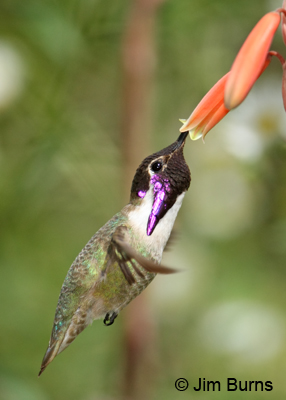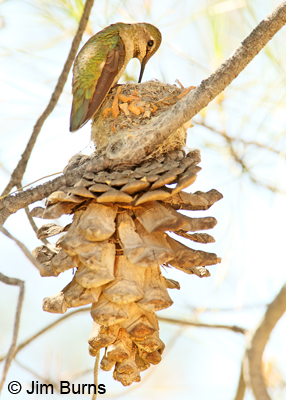|
Anna's Hummingbird female feeding nestlings |
I'm guessing a poll seeking to establish humans' favorite family of birds would come up "hummingbird," especially if it were aimed at the demographic I would label "casual birder." I'm also guessing hummingbirds are the most viewed species on the planet because of the popularity and user friendliness of backyard feeders. Many feeder watchers might not know a sparrow from an eagle, but watch "their" hummers daily and know their schedules, preferred flowers, and nesting habits intimately.
These flying jewels are recognized and beloved for their brilliant colors and the unique physical adaptations which make their fascinating lifestyle possible. This column explores and explodes some myths and mysteries of that lifestyle. They can fly forward and backward, up and down, and hover in place? Yes! They migrate on the backs of geese? No! This is purely an urban legend born of observations of hummingbirds attacking geese (and other larger birds including even hawks) to drive them from their territories.
Hummingbirds are green? Well, most but not all have green backs, but for spectacular iridescent colors and quick identification purposes check out the gorgets of the males. The 'gorget' is the patch of feathers on the throat and originally referred to the plate on a suit of armor that protected a knight's throat.
Hummingbirds live on flower nectar? No. Nectar provides the energy source needed by a tiny bird that beats its wings between 20 and 80 times per second(!), but hummers need protein too. They spend much of their day gleaning foliage and spider webs for insects and "hawking" gnats out of the air.
Hummingbirds mate for life? Are you kidding me? Male hummingbirds are among the most promiscuous of birds, and this family produces more hybrids than any other. Males bring only one thing to the entire breeding process and you know what that is. Female hummers build the nest, feed and raise the young entirely by themselves.
Hummingbirds are intelligent? Yes. There are countless stories about the same hummer returning to the same feeder year after year on almost the exact same date after a 500 mile nonstop migration across the Gulf of Mexico. And they can fly 60 mph during courtship displays, yet pull up instantly just inches off the ground.
Hummingbirds are mean? Let's use an equally anthropomorphic but less judgmental term such as "pugnacious" or perhaps "feisty." Because of their high energy demands they zealously guard and defend food sources like your backyard feeder or flower patch, driving off other hummers and larger birds. Remember, they've been observed dive bombing hawks(!).
For a fun and informative read, anyone interested in hummingbirds should buy a great little book hot off the presses, Do Hummingbirds Hum?, by George West, a professional ornithologist who has been banding and studying hummers right here in Arizona for ten years. Arizona is the hummingbird capital of the country where it's possible in late summer to observe up to 15 different species in one day at feeding stations in the sky islands in the southeastern part of our state.
